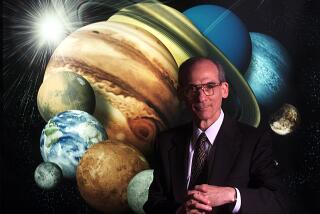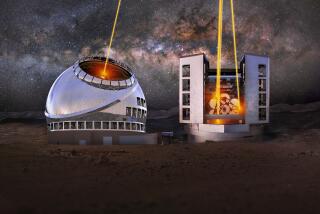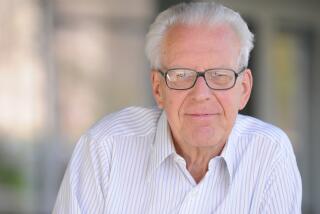A Kavli Prize winner, on the universe and more
Maarten Schmidt, a professor emeritus of astronomy at Caltech, has spent a lifetime studying some of the most exotic denizens of the cosmos. Schmidt, a 78-year-old native of Holland, is credited with revealing the first known quasar in the early 1960s. This week, he became a co-winner of the first Kavli Prize in astrophysics, a $1-million award funded by Southern California entrepreneur and philanthropist Fred Kavli. Schmidt spoke in his office at Caltech.
--
What are quasars?
These objects are very massive but small black holes. They have masses on the order of a billion times the sun. The black hole itself is small, sort of the size of the solar system.
--
What are you working on now?
Iâm working on gamma-ray bursts for the last 10 to 15 years. They are stars that explode and . . . have a fireball that is so intense that, for a short time, that star is brighter than anything else in the universe.
--
Do you ever wish you could visit the places you have studied?
Oh no. You know so well how empty the universe is. You might say, âWhat do you mean, empty? You study all these interesting things that are all over.â But actually if you were to plunk yourself in the universe . . . itâs exceeding unlikely that youâll hit a star or a quasar or anything else. It would be mostly empty space, with here and there an atom flying by.
--
How did you get interested in astronomy?
I had an uncle who was an amateur astronomer in Holland. He was a pharmacist. One summer, the summer of 1942, he showed me his telescope. I decided to build a telescope myself, which I did from a thick lens that I could find in the workshop of my grandfather. Here I had a very small telescope, and by God it focused. There was an image there.
--
That was during World War II?
It was the middle of the war, occupied Holland. . . . When there was no bread, no butter, no meat, no eggs, no rubber, no coal, no gasoline, when there was nothing, [a friend] and I were building telescopes. So it was great fun. During that time, Holland suffered a blackout imposed by the Germans. You could see stars in the middle of the city.
--
How did you come to the United States?
I went to graduate school in Leiden, in Holland, where my mentor was professor Jan Oort, best known as the man of the Oort cloud of comets. In the old days, that was done by the old-boysâ network. Jan Oort knew astronomers here in Pasadena. It just went like that.
--
Youâve stayed 49 years at Caltech. You must outrank everybody in tenure.
At the Athenaeum, which is our faculty club, I have daily lunch at the so-called round table, which is eight or nine people from very different fields, from physics to astronomy, geology, chemistry, biology, engineering. At our table, we have a 95-year-old. I think he was a student here in the early â30s. So no, no, no. I have been at the table for 15 years.
--
Whatâs the biggest mystery left in astronomy?
The expansion of the universe. You would expect that because of the gravity between galaxies, that it goes slower and slower. . . . It now turns out that rather than decelerating, it is accelerating. There is a repulsive force at work. This thing is 10 to the 120th power smaller than Einstein would have wanted. We just donât know what it is. Itâs called dark energy.
--
Do you believe in God?
I donât. No, no, no. And I imagine at our table, the minority would. But the universe is very mysterious, so that doesnât mean that you think you know it all, or even that everything can be known.
--
How do you think the world will end?
Letâs say civilization, because the Earth will survive. Eventually it will be an asteroid. It always surprises me that major countries, including the United States, are not more prepared to investigate this broadly and to actively think what to do about it. If something big hits the Earth, itâs over.
--







